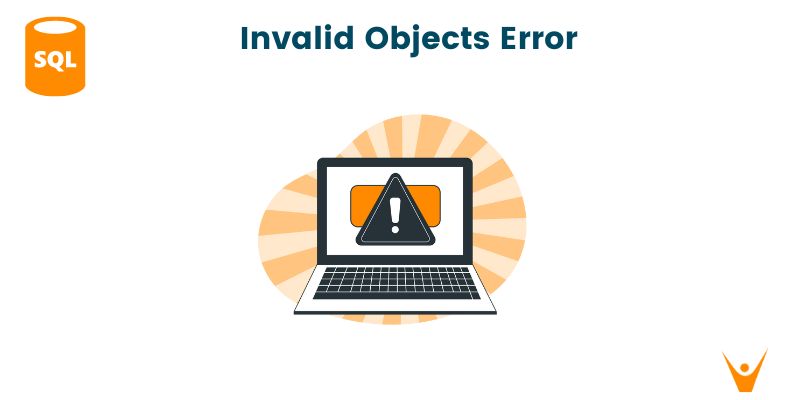In SQL, databases have many interrelated objects, these objects vary differently based on the type of relation. Using the database it becomes essential to maintain the integrity of the database and schema of the stored procedures. In this article, we will look at invalid objects encountered in SQL and also their causes.
Invalid Objects in SQL
Invalid objects in SQL refer to any object that may have been renamed or removed during the process. When modifying the database, if any stored procedure references one table to another and it is dropped then the referenced table acting as the child table is also invalid. We can find the invalid objects when a block of code or script in the database is executed.
In SQL invalid objects, errors generally occur when we create a database and there are syntax errors in code or when objects in a database have dependencies on each other and some of them fail to get referred to each other.
Let us understand this through an example. Creating a customer table:
CREATE TABLE customer ( customer_id INT PRIMARY KEY, customer_name VARCHAR(255) ); INSERT INTO customer VALUES (1, 'John Doe'); INSERT INTO customer VALUES (2, 'Jane Smith'); INSERT INTO customer VALUES (3, 'Bob Johnson'); SELECT * FROM Customer;
Output:

Creating a product table:
CREATE TABLE product ( product_id INT PRIMARY KEY, product_name VARCHAR(255), price DECIMAL(10, 2) ); INSERT INTO product VALUES (1, 'Product A', 50.00); INSERT INTO product VALUES (2, 'Product B', 75.00); INSERT INTO product VALUES (3, 'Product C', 30.00); SELECT * FROM product;
Output:

Creating a sales table:
CREATE TABLE sales ( sale_id INT PRIMARY KEY, customer_id INT, product_id INT, quantity INT, total_amount DECIMAL(10, 2), FOREIGN KEY (customer_id) REFERENCES customer(customer_id), FOREIGN KEY (product_id) REFERENCES product(product_id) ); INSERT INTO sales VALUES (1, 1, 1, 2, 100.00); INSERT INTO sales VALUES (2, 2, 2, 3, 225.00); INSERT INTO sales VALUES (3, 3, 3, 5, 150.00); SELECT * FROM Sales;
Output:

Creating a stored procedure to calculate total sales for a given customer:
DELIMITER (to set the parameter)//CREATE PROCEDURE CalculateTotalSales(IN customerIdParam INT)BEGIN SELECT customer.customer_name, SUM(sales.total_amount) AS total_sales FROM customer JOIN sales ON customer.customer_id = sales.customer_id WHERE customer.customer_id = customerIdParam;END //DELIMITER ;
Creating a view:
CREATE VIEW ProductSalesView AS SELECT product.product_id, product.product_name, product.price, sales.quantity, sales.total_amount FROM product JOIN sales ON product.product_id = sales.product_id; SELECT * FROM ProductSalesView;
Output:

Dropping the table:
DROP TABLE product;
Selecting from the view:
SELECT * FROM ProductSalesView;
Output:

As we can see in this example once the metadata structure has been modified the compiler shows “invalid object” as the output.
Causes of Invalid Objects in SQL
There are various causes which should be considered for an invalid object, various tables and values are referred to each other and once one of them is dropped or modified it may affect the whole architecture of the database.
- Dropping Objects: If we drop a table or another object that is referenced by another object such as a view or stored procedure, the dependent objects become invalid. For example, if a view references a table, and that table is dropped, the view becomes invalid.
- Renaming Objects: Renaming an object may cause a conflict in the dependencies which can cause invalidation. For example, renaming a column that is referenced in a view can invalidate the view.
- Compilation Errors: Compilation errors in the stored procedure or function can be the reason behind the object being invalid.
- Modifying Objects: When we modify the objects we are also changing the structure of a referenced object which affects the dependency of the other objects.
How do I fix invalid object name errors in SQL?
We can fix invalid object name errors in SQL by checking the referenced objects and their names for typos, if the object name is dropped it can be created again or restored from the database backup. Using a systematic approach we can identify invalid objects and rectify them. Sometimes these objects have errors when there are schema changes or metadata recompilation.
How do I find invalid objects in SQL?
Finding invalid objects in SQL is easy, we can use “user_objects “ or “all_objects'” which will show us the objects with “Invalid” status. These statuses are based on the object's relationship in the tables.
There are specific system views that provide and store information, in oracle, we have “DBA_OBJECTS” whereas Microsoft SQL Server and MySQL have “sys.objects” and “information_schema” respectively.
Conclusion
In conclusion, this article addressed the issue of invalid objects in SQL and how crucial it is to maintain consistency in the database. This invalidity in the objects occurs due to dropped, modified, or compilation errors. Using an example we understood the importance of relational databases and how they are connected.








